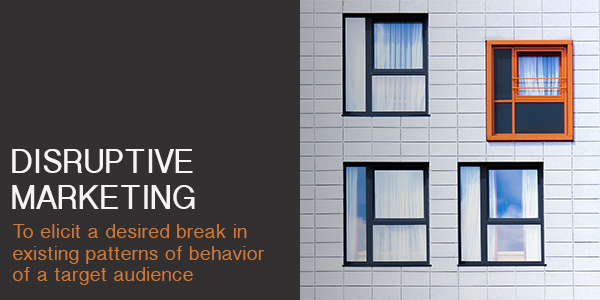Disruptive marketing—it’s in every modern marketer’s playbook.
By definition, disruptive marketing means “to elicit a desired break in existing patterns of behavior of a target audience.”
Similarly, there is a behavioral technique called “disrupt and redirect.” Essentially, it’s what marketers are doing when they get customers to behave differently from status-quo behavior for the purpose of increasing acquisition, engagement, loyalty, and revenue.

Disrupt and Redirect Toward a New Behavior
The objective of disrupt and redirect is to get a person to acknowledge the feelings and beliefs associated with doing something a particular way. Then, you build new thought patterns—and strengthen the “feeling” state—by supporting a new and positive action.
Imagine a “connect the dots” drawing.
Start your pencil at #1, then connect to #2, 3, 4, etc. until you finish the drawing. The route is predetermined and follows a logical order. Alternatively, consider starting your pencil at #1, and jump to 3, 5, 7, 8, and 10. Suddenly you’ve created a brand new pattern or image. Moving your pencil from #1 to 3 is a disruption of an expected pattern.
Process Demonstrated
Let’s say that I am working with an individual who overuses their credit cards and has a significant debt issue. First, I ask the person what is the behavior they want to change? (They have $6,000 worth of credit card debt and are financially in over their head).
Second, I ask what’s their specific objective, if they were to behave differently.
For example, their objective may be to cut back on their credit card debt by 25% in three months.
“Lean In” to Build Trust
First, I allow the person to “lean in” and share a typical example of how they would behave, allowing them to express their fears and anger around the behavior. This is to build trust and a sense of security confirming that I hear the person’s issue clearly and to give them a voice to express themselves. Building trust is essential to invoking change.
Step into Another’s Shoes to Show Empathy
Next, empathize with the person’s pain points—step into the person’s shoes. I imagine (and verbally acknowledge) what being deep into debt would mean; always afraid for my ability to pay bills, angry with myself for the choices I’ve made, fearful about my future financial stability, etc.
Amplify Feelings (and Experience) of Normal Behavior
Finally, I let the person go to a specific pain point in their own mind. The person frequently buys products online (immediate gratification) without any thought of the consequences on their debt. I have them imagine a credit card in their hand, the feeling of excitement, heart beating fast, the rush as they are about to purchase another $150 cashmere sweater (that they own in a similar color and style). They input their credit information and are ready to press the “complete purchase” button.
Disrupt!
At the moment just before, I tell the person to stop for a moment and think about what the impact will be of purchasing this product. How would it help them to decrease their debt by 25% in three months? This action disrupts their normal behavioral pattern. Then I have the person imagine the product will be available in 24 hours, and ask them to agree to wait 24 hours before purchasing the product. They can choose in 24 hours to purchase if they absolutely need this product.
Redirect!
Have the person imagine what it would be like to NOT purchase the sweater, decrease their debt, and “moving the needle” toward their positive financial goal. I also have them imagine what they could do when they have decreased their debt by 25%. They might breath a bit easier, feel more confident in their ability to manage money, be able to plan for long term goals such as buying a house. Amplify their feelings of confidence, joy, and success in meeting their goal.
Applying Disruption to B2B Marketing
A simple macro example of B2B disruption is changing from one or two non-traditional channels of communicating with your prospective customers to multiple channels throughout the sales cycle. For example, in the past you mostly communicated with your customer via phone or email to sell the company and the benefits of your products. Now, you utilize drip email campaigns, follow-up with an initial phone call, send self-directed product demos, provide YouTube videos, and webinars. Then you follow-up with an in-person presentation to close a deal. You get the picture.
Coming up…
In my next blog I will give you a detailed example of how you can apply the “disrupt and redirect” technique to your B2B marketing. Stay tuned….

